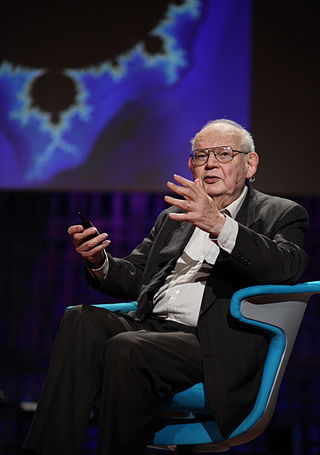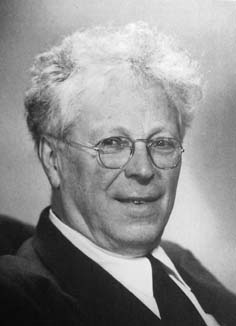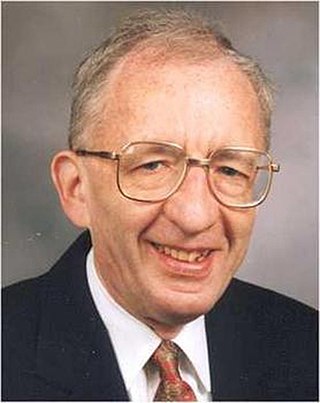Related Research Articles

Benoit B.Mandelbrot was a Polish-born French-American mathematician and polymath with broad interests in the practical sciences, especially regarding what he labeled as "the art of roughness" of physical phenomena and "the uncontrolled element in life". He referred to himself as a "fractalist" and is recognized for his contribution to the field of fractal geometry, which included coining the word "fractal", as well as developing a theory of "roughness and self-similarity" in nature.

In mathematics, a fractal is a geometric shape containing detailed structure at arbitrarily small scales, usually having a fractal dimension strictly exceeding the topological dimension. Many fractals appear similar at various scales, as illustrated in successive magnifications of the Mandelbrot set. This exhibition of similar patterns at increasingly smaller scales is called self-similarity, also known as expanding symmetry or unfolding symmetry; if this replication is exactly the same at every scale, as in the Menger sponge, the shape is called affine self-similar. Fractal geometry lies within the mathematical branch of measure theory.

In mathematics, Hausdorff dimension is a measure of roughness, or more specifically, fractal dimension, that was introduced in 1918 by mathematician Felix Hausdorff. For instance, the Hausdorff dimension of a single point is zero, of a line segment is 1, of a square is 2, and of a cube is 3. That is, for sets of points that define a smooth shape or a shape that has a small number of corners—the shapes of traditional geometry and science—the Hausdorff dimension is an integer agreeing with the usual sense of dimension, also known as the topological dimension. However, formulas have also been developed that allow calculation of the dimension of other less simple objects, where, solely on the basis of their properties of scaling and self-similarity, one is led to the conclusion that particular objects—including fractals—have non-integer Hausdorff dimensions. Because of the significant technical advances made by Abram Samoilovitch Besicovitch allowing computation of dimensions for highly irregular or "rough" sets, this dimension is also commonly referred to as the Hausdorff–Besicovitch dimension.

Abram Samoilovitch Besicovitch was a Russian mathematician, who worked mainly in England. He was born in Berdyansk on the Sea of Azov to a Karaite Jewish family.

In mathematics, the Weierstrass function is an example of a real-valued function that is continuous everywhere but differentiable nowhere. It is an example of a fractal curve. It is named after its discoverer Karl Weierstrass.

Richard Kenneth Guy was a British mathematician. He was a professor in the Department of Mathematics at the University of Calgary. He is known for his work in number theory, geometry, recreational mathematics, combinatorics, and graph theory. He is best known for co-authorship of Winning Ways for your Mathematical Plays and authorship of Unsolved Problems in Number Theory. He published more than 300 scholarly articles. Guy proposed the partially tongue-in-cheek "strong law of small numbers", which says there are not enough small integers available for the many tasks assigned to them – thus explaining many coincidences and patterns found among numerous cultures. For this paper he received the MAA Lester R. Ford Award.

The Ascension Parish Burial Ground, formerly known as the burial ground for the parish of St Giles and St Peter's, is a cemetery off Huntingdon Road in Cambridge, England. Many notable University of Cambridge academics are buried there, including three Nobel Prize winners.
Patrick du Val was a British mathematician, known for his work on algebraic geometry, differential geometry, and general relativity. The concept of Du Val singularity of an algebraic surface is named after him.

Linda Jo Goldway Keen is an American mathematician and a fellow of the American Mathematical Society. Since 1965, she has been a professor in the Department of Mathematics and Computer Science at Lehman College of the City University of New York and a Professor of Mathematics at Graduate Center of the City University of New York.
The Etta Z. Falconer Lecture is an award and lecture series which honors "women who have made distinguished contributions to the mathematical sciences or mathematics education". It is sponsored by the Association for Women in Mathematics and the Mathematical Association of America. The lectures began in 1996 and were named after the mathematician Etta Z. Falconer in 2004 "in memory of Falconer's profound vision and accomplishments in enhancing the movement of minorities and women into scientific careers". The recipient presents the lecture at MathFest each summer.

George Chrystal FRSE FRS was a Scottish mathematician. He is primarily known for his books on algebra and his studies of seiches which earned him a Gold Medal from the Royal Society of London that was confirmed shortly after his death.

Alan Baker was an English mathematician, known for his work on effective methods in number theory, in particular those arising from transcendental number theory.

The Regius Professorship of Mathematics is the name given to three chairs in mathematics at British universities, one at the University of St Andrews, founded by Charles II in 1668, the second one at the University of Warwick, founded in 2013 to commemorate the Diamond Jubilee of Elizabeth II and the third one at the University of Oxford, founded in 2016.
Louis Melville Milne-Thomson CBE FRSE RAS was an English applied mathematician who wrote several classic textbooks on applied mathematics, including The Calculus of Finite Differences, Theoretical Hydrodynamics, and Theoretical Aerodynamics. He is also known for developing several mathematical tables such as Jacobian Elliptic Function Tables. The Milne-Thomson circle theorem and the Milne-Thomson method for finding a holomorphic function are named after him. Milne-Thomson was made a Commander of the Order of the British Empire (CBE) in 1952.

Claude Ambrose Rogers FRS was an English mathematician who worked in analysis and geometry.

In geometry, the midpoint polygon of a polygon P is the polygon whose vertices are the midpoints of the edges of P. It is sometimes called the Kasner polygon after Edward Kasner, who termed it the inscribed polygon "for brevity".
Igor Rivin is a Russian-Canadian mathematician, working in various fields of pure and applied mathematics, computer science, and materials science. He was the Regius Professor of Mathematics at the University of St. Andrews from 2015 to 2017, and was the chief research officer at Cryptos Fund until 2019. He is doing research for Edgestream LP, in addition to his academic work.

Caroline Mary Series is an English mathematician known for her work in hyperbolic geometry, Kleinian groups and dynamical systems.
Pertti Esko Juhani Mattila is a Finnish mathematician working in geometric measure theory, complex analysis and harmonic analysis. He is Professor of Mathematics in the Department of Mathematics and Statistics at the University of Helsinki, Finland.
A magic polygon is a polygonal magic graph with integers on its vertices.
References
- 1 2 3 4 5 "Kenneth Falconer's homepage at St Andrews University".
- ↑ "Warrants Under the Royal Sign Manual: Regius Chair of Mathematics". The Gazette. 22 December 2017.
- ↑ Kenneth Falconer at the Mathematics Genealogy Project
- ↑ "LMS Prize Winners 2020". London Mathematical Society. Retrieved 2 April 2021.
- ↑ "No. 64269". The London Gazette (Supplement). 30 December 2023. p. N10.
- ↑ "40th Anniversary issue". Strider. Long Distance Walkers Association. September 2012.
- ↑ "The Long Distance Walkers Association on Twitter" . Retrieved 2 April 2021– via Twitter.
- ↑ "Scottish Mountaineering Club, Munro Compleatists".